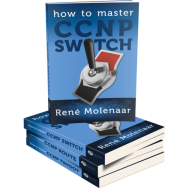Scenario:
After passing the CCNA exam you feel like you could do anything with NAT. You just started at a new job as a junior network engineer but to your surprise the router you are working on doesn’t have any “inside” or “outside” commands. It does create a NVI interface but you have no idea what it is…let’s see if you can configure NAT anyway…
Goal:
- All IP addresses have been preconfigured for you.
- Configure NAT so hosts on network 192.168.12.0 /24 are translated to network 192.168.23.0 /24.
- You are not allowed to use the “ip nat inside” or “ip nat outside” command.
IOS:
c3640-jk9s-mz.124-16.bin
Topology:

Video Solution:
Configuration Files
You need to register to download the GNS3 topology file. (Registration is free!)Once you are logged in you will find the configuration files right here.

Do you want your CCNA or CCNP Certificate?
The How to Master series helps you to understand complex topics like spanning-tree, VLANs, trunks, OSPF, EIGRP, BGP and more.
Written by René Molenaar - CCIE #41726


Great Lab. Used to inside/outside. A nice different approach. Any advantage?
There are some differences/advantages to the NAT Virtual interface. There’s a great post by Petr Lapukhov on INE that I can recommend you to read:
http://blog.ine.com/2008/02/15/the-inside-and-outside-of-nat/
Bro,
i want to personally thank you for your great efforts, currently i don’t have enough money to purchase ur products but as far as i will have extra money i will buy, maybe then i will not need them but to encourage people like you to support us, man u r really one of a kind
Greetings from an Arabian Land
Ahmed